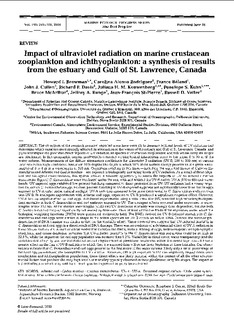| dc.description.abstract | The objectives of the research program reported upon here were (1) to measure ambient levels of UV radiation and
determine whichvariables most strongly affected its attenuation in the waters of the estuary and Gulf of St. Lawrence, Canada; and
(2) to investigate the potential direct impacts of W radiation on species of crustacean zooplankton and fish whose early life stages
are planktonic. In this geographic region, productivity-determining biophysical interactions occur in the upper 0 to 30 m of the
water column. Measurements of the diffuse attenuation coefficients for ultraviolet-B radiation (W-B, 280 to 320 nm) at various
locations in this region indicated maximum 10% depths (the depth to which 10% of the surface energy penetrates at a given wavelength)
of 3 to 4 m at a wavelength of 310 nm. Organisms residing in this layer-including the eggs and larvae of Calanus finmarchicus
and Atlantic cod Gadus morhua-are exposed to biologically damaging levels of W radiation. As a result of these physical
and biological characteristics, this system offered a relevant opportunity to assess the impacts of UV on subarctic marine
ecosystems. Eggs of C. finmarchicus were incubated under the sun, with and without the W-B and/or UV-A (320 to 400 nm) wavebands.
W-exposed eggs exhibited low percent hatchmg compared to those protected from W : W radiation had a strong negative
impact on C. finmarchicus eggs. Further, percent hatching in W-B-exposed eggs was not significantly lower than that in eggs
exposed to UV-A only: under natural sunlight, UV-A radiation appeared to be more detrimental to C. finmarchicus embryos than
was UV-B. In analogous experiments with Atlantic cod eggs, exposure to UV-B produced a significant negative effect. However,
UV-A had no negative effect on cod eggs. Additional experiments using a solar simulator (SS) revealed high wavelength-dependent
mortality in both C. finmarchicus and cod embryos exposed to UV. The strongest effects occurred under exposures to wavelengths
below 312 nm. At the shorter wavelengths (<305 nm) UV-B-induced mortality was strongly dose-dependent, but (for both
C. finmarchicus and cod) not significantly influenced by dose-rate. Thus, at least within the limits of the exposures under which the
biological weighting functions (BWFs) were generated, reciprocity held. The BWFs derived for UV-B-induced mortality in C. finmarchicus
and cod eggs were similar in shape to the action spectrum for UV-B effects on naked DNA. Further, the wavelengthdependence
of DNA damage was similar to that for the mortality effect. These observations suggest that W-induced mortality in
C. finmarchicus and cod eggs is a direct result of DNA damage. There was no evidence of a detrimental effect of UV-A radiation in
these SS-derived results. A mathematical model that includes the BWFs, vertical mixing of eggs, meteorological and hydrographic
conditions, and ozone depletion, indicates that W-induced mortality in the C. finmarchicus egg population could be as high as
32.5 %, while the impact on the cod egg population was no more than 1.2%. Variability in cloud cover, water transparency (and the
variables that affect it), and vertical distribution and displacement of planktonic organisms within the mixed layer can all have a
greater effect on the flux of UV-B radiation to which they are exposed than will ozone layer depletion at these latitudes. Our observations
indicate that C, finmarchicus and cod eggs present in the first meter of the water column (likely only a small percentage of
the total egg populations) are susceptible to W radiation. However, although exposure to UV can negatively impact crustacean
zooplankton and ichthyoplankton populations, these direct effects are likely minimal within the context of all the other environmental
factors that produce the very high levels of mortality typically observed in their planktonic early life stages. The impact of
indnect effects-which may well be of much greater import-has yet to be evaluated. | en |
